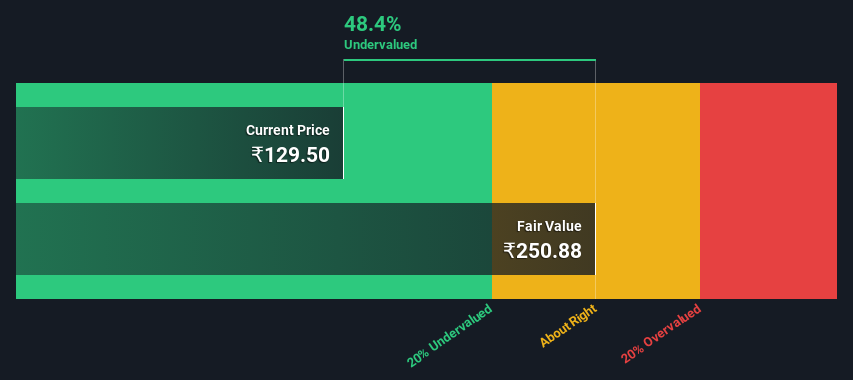Is There An Opportunity With Himatsingka Seide Limited's (NSE:HIMATSEIDE) 48% Undervaluation?

Key Insights
- The projected fair value for Himatsingka Seide is ₹251 based on 2 Stage Free Cash Flow to Equity
- Current share price of ₹130 suggests Himatsingka Seide is potentially 48% undervalued
- Peers of Himatsingka Seide are currently trading on average at a 1,331% premium
Today we will run through one way of estimating the intrinsic value of Himatsingka Seide Limited (NSE:HIMATSEIDE) by taking the expected future cash flows and discounting them to today's value. This will be done using the Discounted Cash Flow (DCF) model. Models like these may appear beyond the comprehension of a lay person, but they're fairly easy to follow.
We generally believe that a company's value is the present value of all of the cash it will generate in the future. However, a DCF is just one valuation metric among many, and it is not without flaws. Anyone interested in learning a bit more about intrinsic value should have a read of the Simply Wall St analysis model.
See our latest analysis for Himatsingka Seide
The Model
We are going to use a two-stage DCF model, which, as the name states, takes into account two stages of growth. The first stage is generally a higher growth period which levels off heading towards the terminal value, captured in the second 'steady growth' period. To begin with, we have to get estimates of the next ten years of cash flows. Where possible we use analyst estimates, but when these aren't available we extrapolate the previous free cash flow (FCF) from the last estimate or reported value. We assume companies with shrinking free cash flow will slow their rate of shrinkage, and that companies with growing free cash flow will see their growth rate slow, over this period. We do this to reflect that growth tends to slow more in the early years than it does in later years.
Generally we assume that a dollar today is more valuable than a dollar in the future, and so the sum of these future cash flows is then discounted to today's value:
10-year free cash flow (FCF) estimate
| 2024 | 2025 | 2026 | 2027 | 2028 | 2029 | 2030 | 2031 | 2032 | 2033 | |
| Levered FCF (₹, Millions) | ₹3.49b | ₹4.42b | ₹5.18b | ₹5.91b | ₹6.62b | ₹7.30b | ₹7.98b | ₹8.66b | ₹9.36b | ₹10.1b |
| Growth Rate Estimate Source | Analyst x1 | Analyst x2 | Est @ 17.23% | Est @ 14.10% | Est @ 11.91% | Est @ 10.38% | Est @ 9.30% | Est @ 8.55% | Est @ 8.03% | Est @ 7.66% |
| Present Value (₹, Millions) Discounted @ 26% | ₹2.8k | ₹2.8k | ₹2.6k | ₹2.3k | ₹2.1k | ₹1.8k | ₹1.6k | ₹1.3k | ₹1.1k | ₹979 |
("Est" = FCF growth rate estimated by Simply Wall St)
Present Value of 10-year Cash Flow (PVCF) = ₹19b
We now need to calculate the Terminal Value, which accounts for all the future cash flows after this ten year period. For a number of reasons a very conservative growth rate is used that cannot exceed that of a country's GDP growth. In this case we have used the 5-year average of the 10-year government bond yield (6.8%) to estimate future growth. In the same way as with the 10-year 'growth' period, we discount future cash flows to today's value, using a cost of equity of 26%.
Terminal Value (TV)= FCF2033 × (1 + g) ÷ (r – g) = ₹10b× (1 + 6.8%) ÷ (26%– 6.8%) = ₹55b
Present Value of Terminal Value (PVTV)= TV / (1 + r)10= ₹55b÷ ( 1 + 26%)10= ₹5.4b
The total value, or equity value, is then the sum of the present value of the future cash flows, which in this case is ₹25b. To get the intrinsic value per share, we divide this by the total number of shares outstanding. Relative to the current share price of ₹130, the company appears quite undervalued at a 48% discount to where the stock price trades currently. The assumptions in any calculation have a big impact on the valuation, so it is better to view this as a rough estimate, not precise down to the last cent.

Important Assumptions
We would point out that the most important inputs to a discounted cash flow are the discount rate and of course the actual cash flows. If you don't agree with these result, have a go at the calculation yourself and play with the assumptions. The DCF also does not consider the possible cyclicality of an industry, or a company's future capital requirements, so it does not give a full picture of a company's potential performance. Given that we are looking at Himatsingka Seide as potential shareholders, the cost of equity is used as the discount rate, rather than the cost of capital (or weighted average cost of capital, WACC) which accounts for debt. In this calculation we've used 26%, which is based on a levered beta of 2.000. Beta is a measure of a stock's volatility, compared to the market as a whole. We get our beta from the industry average beta of globally comparable companies, with an imposed limit between 0.8 and 2.0, which is a reasonable range for a stable business.
SWOT Analysis for Himatsingka Seide
- No major strengths identified for HIMATSEIDE.
- Interest payments on debt are not well covered.
- Expected to breakeven next year.
- Has sufficient cash runway for more than 3 years based on current free cash flows.
- Good value based on P/S ratio and estimated fair value.
- Debt is not well covered by operating cash flow.
Moving On:
Although the valuation of a company is important, it is only one of many factors that you need to assess for a company. DCF models are not the be-all and end-all of investment valuation. Rather it should be seen as a guide to "what assumptions need to be true for this stock to be under/overvalued?" For instance, if the terminal value growth rate is adjusted slightly, it can dramatically alter the overall result. Why is the intrinsic value higher than the current share price? For Himatsingka Seide, there are three relevant items you should consider:
- Risks: You should be aware of the 2 warning signs for Himatsingka Seide (1 makes us a bit uncomfortable!) we've uncovered before considering an investment in the company.
- Future Earnings: How does HIMATSEIDE's growth rate compare to its peers and the wider market? Dig deeper into the analyst consensus number for the upcoming years by interacting with our free analyst growth expectation chart.
- Other Solid Businesses: Low debt, high returns on equity and good past performance are fundamental to a strong business. Why not explore our interactive list of stocks with solid business fundamentals to see if there are other companies you may not have considered!
PS. Simply Wall St updates its DCF calculation for every Indian stock every day, so if you want to find the intrinsic value of any other stock just search here.
If you're looking to trade Himatsingka Seide, open an account with the lowest-cost platform trusted by professionals, Interactive Brokers.
With clients in over 200 countries and territories, and access to 160 markets, IBKR lets you trade stocks, options, futures, forex, bonds and funds from a single integrated account.
Enjoy no hidden fees, no account minimums, and FX conversion rates as low as 0.03%, far better than what most brokers offer.
Sponsored ContentValuation is complex, but we're here to simplify it.
Discover if Himatsingka Seide might be undervalued or overvalued with our detailed analysis, featuring fair value estimates, potential risks, dividends, insider trades, and its financial condition.
Access Free AnalysisHave feedback on this article? Concerned about the content? Get in touch with us directly. Alternatively, email editorial-team (at) simplywallst.com.
This article by Simply Wall St is general in nature. We provide commentary based on historical data and analyst forecasts only using an unbiased methodology and our articles are not intended to be financial advice. It does not constitute a recommendation to buy or sell any stock, and does not take account of your objectives, or your financial situation. We aim to bring you long-term focused analysis driven by fundamental data. Note that our analysis may not factor in the latest price-sensitive company announcements or qualitative material. Simply Wall St has no position in any stocks mentioned.
About NSEI:HIMATSEIDE
Himatsingka Seide
Designs, develops, manufactures, distributes, and retails home textile products in North America, India, the Asia Pacific, Europe, the Middle East, Africa, and internationally.
Fair value with mediocre balance sheet.
Similar Companies
Market Insights
Community Narratives



